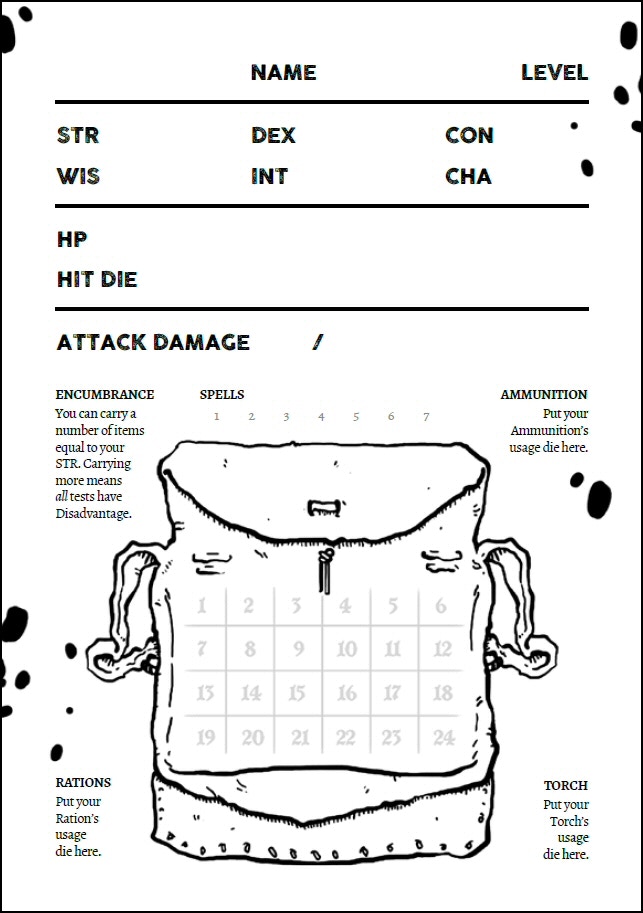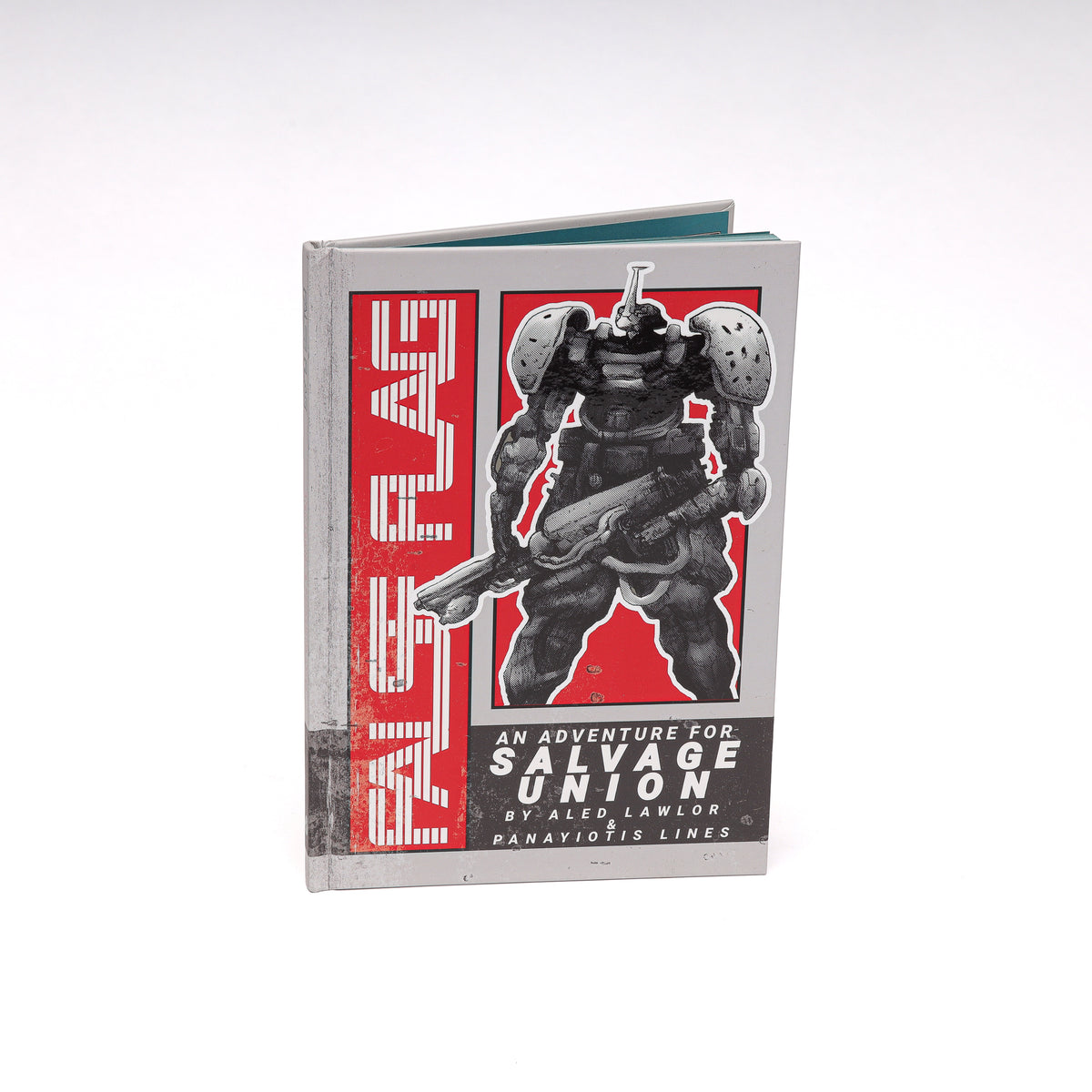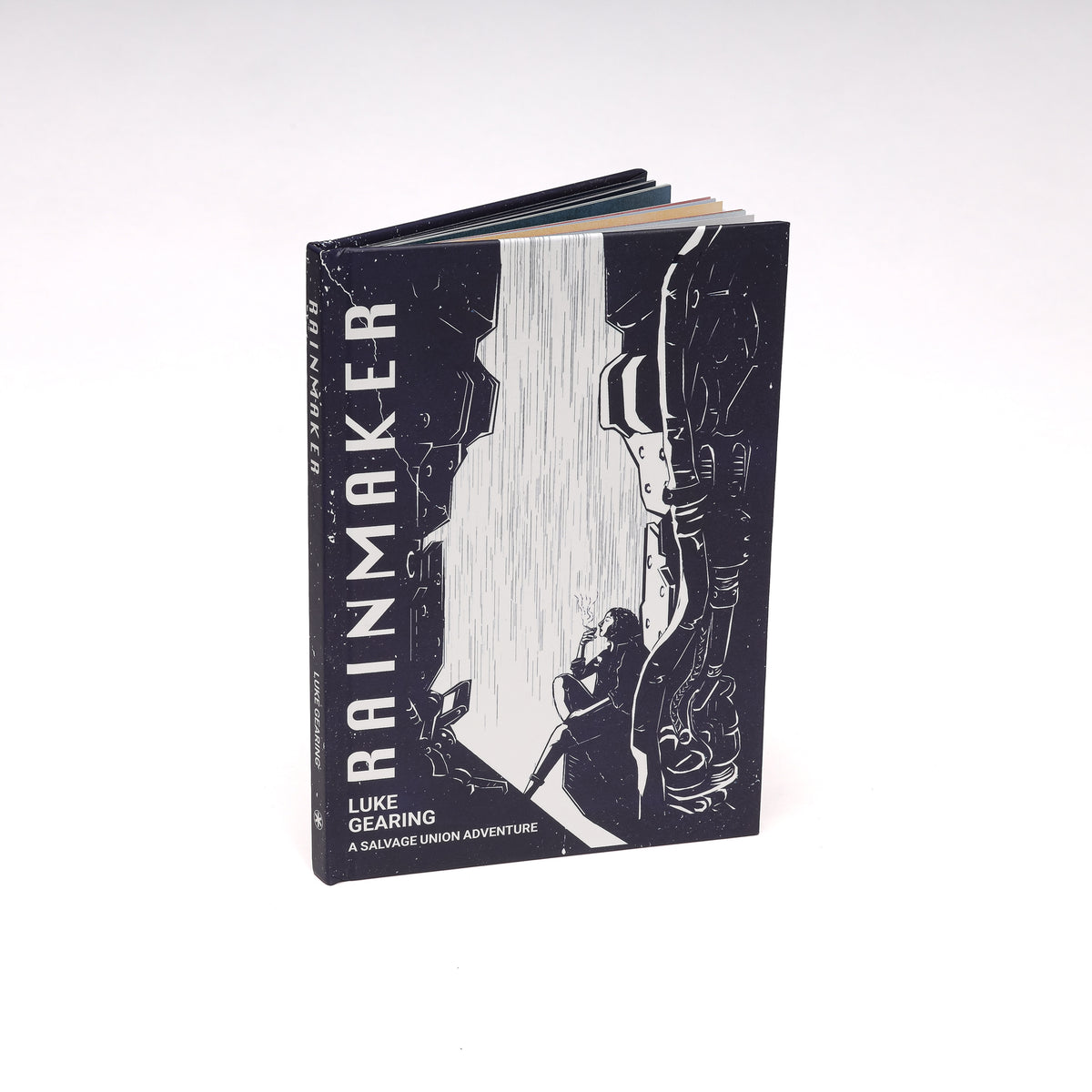
In this series of blogs we're exploring the various OSR RPG systems in the community and how they compare to one another and the original D&D rules.
This week we're taking a look at The Black Hack 2nd Edition by David Black
The Black Hack, similarly to Whitehack and Swords & Wizardry, uses original D&D as a base but greatly innovates with the formula.
The Black Hack aims to provide a clean set of streamlined rules that will get you into the adventure as quickly as possible. These have been designed to be ran at conventions where time and space is limited. It's design echoes this, the core rules are presented in a slimline, A5 booklet that runs a mere 18 pages or so. There's an additional small booklet of monsters and some cute additions like a mini GM screen and tiny A6 spell books. You can hand these to players playing the Wizard or Cleric respectively rather than them trawling through the core book.

The game uses the standard 6 stats from original D&D (Strength, Dexterity, Constitution, Intelligence, Wisdom, Charisma). These are as with original D&D generated randomly by rolling 3d6 for each stat. The Black Hack adds a rule to this process that if you roll a 14+ then you don't roll for the next attribute, instead it has to be a 7. This means particularly high stats will contrast with low stats. A strong character wont be dexterous, an intelligent character wont be wise and a wise character wont be charismatic.
You can however swap any two attributes of your choice if it suits your character better so you're not entirely tied to the whims of the dice. You don't get any attribute bonuses in the game, instead the ability score you roll is the most important and relevant number to refer to in play.
The core of the game uses a d20 roll under mechanic. When attempting anything you roll a d20 and try to get under a relevant ability score. For example if you were attempting to balance on a ledge and have a Dexterity of 13 you would need to roll under 13 to succeed. This also means Saving Throws have been removed entirely from the game, instead everything works off of this core mechanic. This is the case whether actively doing something or reacting to something happening to you.

After this you pick from 4 classes that mirror the classic 4 D&D classes. The Warrior, Cleric, Wizard and Thief. In addition to this decision at character creation you also pick a background for your character, there's a d12 table for inspiration but ultimately it's up to you as a player. Beyond mere fluff this background is intended to actively come up in play as it gives advantage on a roll.
Advantage in this case is the rule from D&D 5th edition where you roll two d20's for a check and pick the highest result when you have some kind of 'advantage' in play. The Black Hack uses both Advantage and Disadvantage as a core tool for the Game's Master (GM) to adjudicate rolls in play. This ties into the core d20 roll under mechanic that the game uses.
This is similar to the roll under mechanic used in the Whitehack but a bit more straight forward. It was also included in Basic & Expert D&D however forms far more of a core to The Black Hack. Hence the inclusion of the 'advantage' mechanic. It further explains why the character creation rule includes a low stat to balance out a high one as your core attribute numbers are significantly more important in this game than they typically would be.
It's important not only because it's presented as the core of the system but also ties into lots of different areas of play.
For example monsters in the Black Hack don't roll to attack as they would in D&D as standard, instead when a monster attacks the player rolls under the appropriate stat to avoid the hit. This is Strength for melee attacks and Dexterity for ranged attacks. All these attacks use abstract range scales as well, so instead of measuring distances in feet you just work out if something is close, nearby, faraway or distant.
Damage is variable and based on the HD of the monster attacking, with a flat average number also given for convenience. For example a HD 1 creature will deal 1d4 (2), a HD 2 will deal 1d6 (3), whilst a HD 10 will deal 1d10+1d12(11). This allows you to quickly work out monster damage on the fly.
That being said there is a monster booklet with a list of classic monsters such as the totally not a beholder 'Bestial Eye' and Lizardmen, Ropers, Liches and Dragons. Oh my. These add some special abilities for these monsters and list out all of the stats you need such as HD and damage.
HD still determines monster hit points as well, with monsters assumed to have d8 HP per hit die as with Moldvay Basic D&D.
Armour within the system acts as a form of damage reduction instead of actively preventing hits. This is done via an Armour Pool system. A character's armour will provide a set number of d6's that they have in their armour pool based on its Armour Value. For example Leather provides 2 Armour Value and Plate provides 4 Armour Value. A shield and helmet adds an additional die to the pool but they don't stack beyond that.
When a character is hit by an attack they can remove an armour die from their pool, declare it 'broken' and prevent all damage from the hit or effect. Armour die that are 'broken' can't be used again but armour can be repaired during a rest by rolling the armour die and getting above the armour's AV. However if this roll is failed then the die remains permanently broken until properly repaired at the likes of a smithy. If all armour die are broken the armour is destroyed.
On the surface it appears strong to be able to prevent a hit however armour will quickly degrade and can't be reliably repaired. So during a long dungeon crawl or wilderness expedition players will soon find their armour in broken bits and be forced to improvise. This could mean scavenging monster armour or bringing multiple suits of armour to a foray. This can then impact your wider encumbrance or waste time, adding additional agency and tough choices to the game. This ties in with the importance of resource management as well as improvisation and player agency as principles within OSR games.
In contrast the standard system of Armour Class used in pretty much every edition of D&D provides a far more stable form of armour that you don't have to actively think about, it just protects you all of the time but doesn't provide much in the way of active choice.
Mork Borg also uses an Armour as Damage Reduction system but armour reduces damage by a flat amount based on the armour type worn. This was closer to how things worked in the first edition of The Black Hack as well. The armour rules are an expanded and more detailed riff of the 'Shields Shall be Splintered' house rule that floats around the old school gaming community.
Initiative is also tied to this d20 roll under mechanic, characters have to make a DEX test when a fight breaks out, those who pass act before the NPC's in any order they wish and those who fail act after the NPC's. This is similar to the system used in Mothership.
This is all a big change to the overall old school D&D combat system. In practice it allows for far more fluid and quick play than in D&D, the GM can focus on telling the players what happens and seeing how they react then asking for rolls when appropriates.
It makes it easier for the GM to run combats as they don't have to track various ranges, initiatives, THAC0/hit values or different damage variables. Instead they can say the HD 1 Merman is attacking you from close range, what do you do?
More agency is thrown over to the players as well, a player may come up with a creative way of avoiding an attack or reacting to something that can be tied into the d20 core mechanics.

To go a bit deeper into the player classes they have a similar clean design. Starting hit points make heavy use of a flat value as constitution doesn't give an attribute bonus. A Warrior gets d4+6 health, a Thief d6+2, a Cleric d6+4 and a Wizard just gets a d4. This is pretty clever and means each class has a set minimum. A Warrior for example always has 7 HP. This is a good balance between the wild nature of Basic DnD where your Fighter could start on 1 HP that still allows for some interesting variability.
When a character hits 0 HP they are unconscious and 'Out of Action'. Once the danger they were in passes they must roll on a d6 table to see what happens. On the roll of a 6 they die, other results include cracked bones, disfigurements or simply being unconscious.
As long as they survive this roll they will regain 1d4 HP and be conscious. This makes The Black Hack a lot less lethal than Basic D&D where you die on 0. It also adds a permanent injury system in a clean, simple way.
If the party can't recover the body or loses the fight they were in then the character is just presumed dead which again adds potential for situations where character agency matters.
Characters can heal HP by resting for an hour then rolling their hit die and regaining that many HP. This is generous compared to Basic D&D where you could gain 1 HP for resting overnight and had no way to heal over a shorter period. This is a somewhat similar but more restrictive variant of the Short Rest healing in 5E D&D.

They also get to roll all of their HD and recover that many HP if they spend an entire day resting. This is also significantly more generous than in Basic where a character would get d3 HP for resting a day.
As with monsters player classes with the exception of the Warrior have a set damage value, a Thief and Cleric always deal 1d6 or 1d4 if unarmed, whilst a Wizard deals 1d4 or 1 if unarmed. This means you don't have to worry about specific weapons and can just flavour that however you choose.
The Warrior, to reflect their fighting ability has the 'Dealer of Death' ability. They have a pool of damage dice equal to their HD that they can distribute among any number of Nearby targets. They describe their attack and roll an Attribute Test for each of these to see if they hit and the pool resets at the start of each turn.
This is similar to the various original D&D rules and house rules over the years that have given the Fighter multiple attacks with various restriction. This makes the Warrior significantly more deadly than their counterpart in Basic D&D.

Other classes don't lose out on cool stuff however, the Thief gets a far more generous 'Backstab' called a 'Sneak Attack'. This auto hits and does 2d6+ the Thief's level in damage if they manage to creep up on an unaware foe. In contrast the Thief in Basic D&D can get double damage on a hit at +4 with that damage typically being d4 or d6. A Thief also just always has a dagger on them, no matter what as a rule.
The Cleric and Wizard of course get their panoply of spells. These are called Prayers for a Cleric and Arcane Spells for the Wizard.
The Cleric has access to a similar feeling list of what you would expect from B/X D&D including the likes of Cure Light Wounds, Light, Dispel Evil and Cure Disease. These spells work in familiar ways, for example Cure Light Wounds heals 1d8, but their wording is significantly condensed. They are memorised much as with the classic Vancian system, however instead of the spell charts in B/X D&D a Cleric can just memorise a number of spells equal to their level. Prayers also don't disappear once cast, the Cleric can make an Attribute Test, adding the prayers level to the roll, and if successful can use the spell again. This roll is taken with Disadvantage if the prayer has been cast twice in a single day.
The Wizard works in pretty much an identical way but gets a different spell list called 'Arcane Spells' with again familiar favourites such as Magic Missile, Sleep, Fireball and Polymorph Self/Other. They as with the Cleric don't forget spells unless they fail their attribute test after casting.
This is neat and gives spellcasters additional flexibility and casting power, especially compared to B/X where a Level 1 Magic-User had 1 spell and a Level 1 Cleric couldn't cast anything at all. However it checks its power well that the spellcasters still aren't going to become overwhelming in their abilities.
There's a smattering of additional cool abilities for each class as well which makes them significantly stronger than their counterparts in B/X D&D but still reigns them in a lot relative to the complexity and strength of your standard 5E D&D character.
Encumbrance is simplified to a slot encumbrance system, a character can carry as much as their strength. If they carry anymore they are Encumbered and have Disadvantage to all of their checks. They cannot carry any more than double their Strength.

There's also a 'Usage Die' mechanic to track individual resources. Instead of say tracking your exact number of oil flasks you assign a 'Usage Die' to them. An Oil Flask has a Usage die of 1d6. When the item is used you roll the Usage Die. If the result is 1-2 then the die is downgraded to its next lowest, in this case a d4. Once an item reduces below a d4 it's assumed nothing is left. This is a similar mechanic to the one used in Forbidden Lands and the wider Year Zero system and allows you to importantly include encumbrance without the time factor of tracking everything individually. It also significantly adds tension to the experience.
Coins are all abstracted into a single currency rather than splitting between Copper/Silver/Gold. Characters no longer get experience for finding coin and instead a character receives an 'Experience' when something interesting happens. They may earn it from defeating a powerful enemy, completing a quest, or even failing in something spectacularly.
When they have a number of 'Experience' equal to their level they can spend it to level up but specifically have to do this during 'Carousing' in an appropriate location such as a settlement. When a character does level up they gain a benefit of their choice based on their class. Everyone broadly gets a chance to improve an Attribute and increase their health by their Hit Die. Spellcasters get access to more spells whilst Warriors and Thieves have their class abilities such as Dealer of Death and Sneak Attack improved by their level.
There's a couple of other important inclusions to the rules from original D&D, Reaction Rolls & Morale, that are cornerstones of OSR play but modified in the Black Hack to play more cleanly and smoothly.
Reaction Rolls are resolved on a 2d6 table but with a far wider variable of results. For example on a 5 they will mistake the PC's for allies, on an 11 they will attempt to Capture the PC's and on a 2 they will surrender or offer allegiance.
Morale is rolled when 50% of a group of NPC's are killed or a single powerful monster is reduced to 50%. The GM tests Morale by rolling on or under the highest Creature's HD with a d12. This again saves looking up specific monster morale values and is a clean way of doing things quickly at the table.

Though The Black Hack makes many changes to the original D&D formula it's still well compatible with any classic old school D&D module as well as any module designed for a modern day retro clone. This is due to it keeping multiple familiar elements that can be ported across but changing them in a unique but consistent manner.
Overall the Black Hack is a clean and light weight package for running OSR style games, character creation is quick, the core resolution mechanic means the GM can adjudicate situations easily and everything being player facing puts the onus on players to describe how they avoid attacks, traps and dangers within the game.
The Black Hack has spawned many other titles including the Cthulhu Hack and The Mecha Hack which we'll explore in other articles.

Thanks for reading! If you're interested in a trio of old school fantasy adventures check out Albion Tales.
Subscribe to the Leyline Press newsletter here to receive updates on our blogs, promotions, games and more.
Follow us on twitter @leylinepress
Follow us on facebook @leylinepress
Follow us on instagram @leylinepress
Follow us on tiktok @leylinepress
Subscribe to this blogs RSS feed by pasting this into your feed reader - https://leyline.press/blogs/leyline-press-blog.atom






0 comments